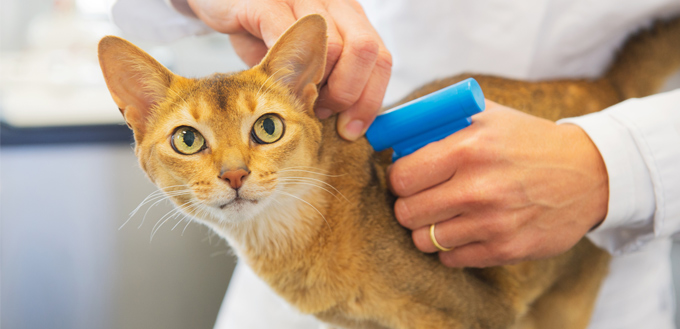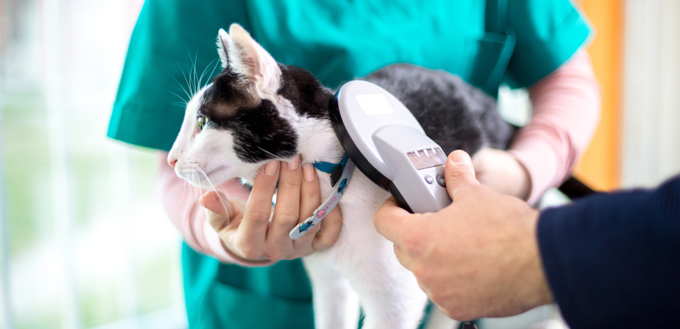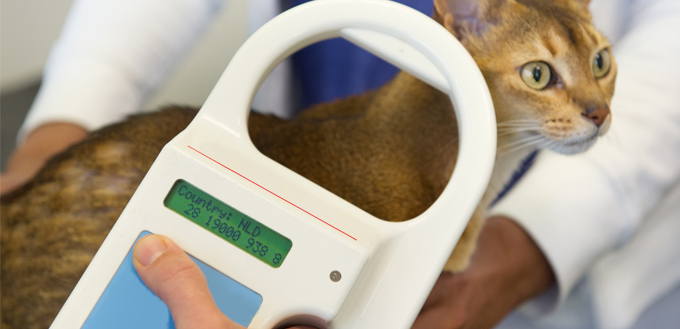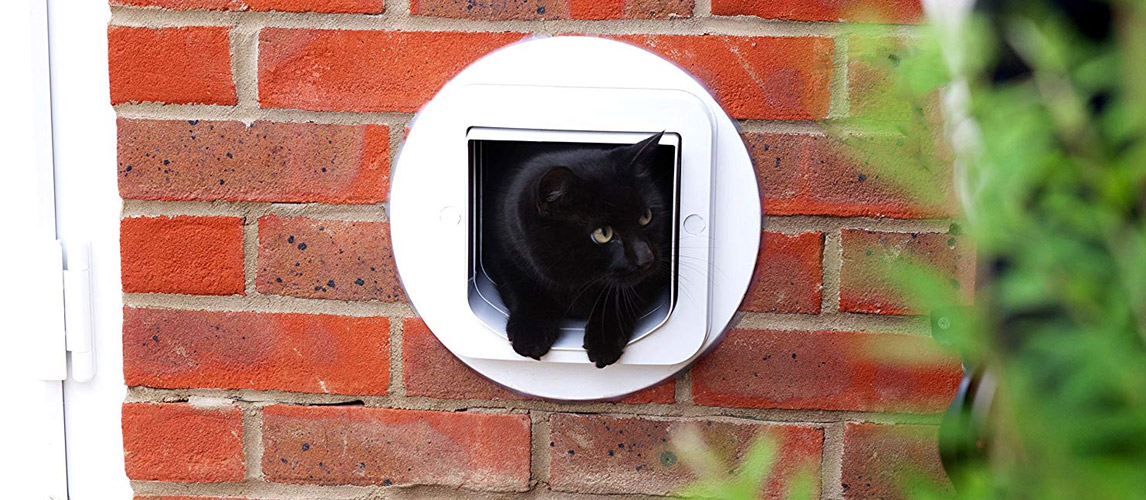We are all familiar with the very sad posters displaying pictures of missing cats and kittens and desperate messages from distraught owners. When a much-loved pet goes missing, the uncertainty is very upsetting. Years ago, we relied on identification tags on cat collars and the goodwill of neighbors to help find missing cats.
Modern technology, however, is changing all that. It is now possible to have a computer microchip containing your contact information inserted into your cat which makes the process of reuniting owners with kitties a lot easier. Nevertheless, the fact that something is possible, does not make it ethical, safe or acceptable to everyone. It is your personal decision. Here are some things that you may want to consider when you are making the decision to have your kitten microchipped.

Microchips: The Basics
A cat microchip ID is about the size as a grain of rice. It consists of a radio transmitter, an antenna and a computer chip with a 10-digit code. The chip code can be read using a special scanner owned by most vets and animal shelters. When scanned, it transmits its number to the scanner and this number corresponds to records (contact details) held about you on a central database. The idea is that you can be contacted and reunited with your cat.
A microchip implant is described as a passive Radio Frequency Identification Device (RFID). This means that it has no internal power source (battery) and remains inactive until it is powered by the scanner.
The microchip uses special technology and stores information ‘passively’ which means that it does not actively transmit information. It is not the same as a Global Positioning System tracker and does not allow you to track the location of your cat. The microchip is considered to be inert and perfectly safe.
You May Also Like: Cat GPS Tracker
It is placed inside your cat by injecting it subcutaneously so that it sits just under the skin, usually between the shoulder blades. Microchips have been known to move around the body from their original site, especially as the cat gets older but there are no reports of the entering or interfering with vital organs.
The Process of Inserting a Microchip
Microchips are inserted by vets. The microchip is sterile and so it will be scanned inside its package to confirm the identification code of the chip. Some vets feel that microchipping causes little pain and is similar to having a blood test. Some administer a little local anesthetic and you have the right to ask for this if you are concerned about causing distress to your cat.
A 12-gauge needle containing the microchip is loaded into either an application gun or syringe. It is best if your kitty is either standing or lying on their stomach during the procedure. The loose skin between the shoulder blades is pulled up and the needle is inserted into the subcutaneous tissue before the applicator trigger is squeezed. Once the chip is in place, your vet will scan it again to make sure that it can be read correctly. The physical procedure is very quick and the paperwork will take a few minutes to complete. You may be able to feel the chip under the skin on the back of your kitty’s neck but this is not always the case.
The Best Time to Get Your Cat Microchipped
It is possible to microchip your little kitten once they reach five weeks old although the age and size of the cat is not the main consideration. It is the health of the cat that matters and kittens below five weeks are simply not robust enough for the procedure. Most cat shelters will not insert a chip until a kitten is over eight weeks old or weighs over two pounds.
Many owners chose to have the microchip inserted at the same time as spaying a cat because they will be under anesthetic anyway. This is at around six months although they may have had an opportunity to go missing before then! There is no upper age limit for microchip insertion as long as the cat is fit and well.

Microchip Safety Concerns
The first concern about microchip safety is the pain that insertion with a large needle may cause your cat. However, most vets report that cats barely flinch during the procedure. You do have the option of local anesthetic or having the chip inserted at the same time as spaying or neutering so your cat will already be anesthetized. There is an extremely small chance of complications arising if your cat moves while the chip is being inserted. A skilled vet should be able to minimize the risks.
The second concern arises because you are effectively introducing a foreign object into your cat’s body. As with any device or implant, there is a potential for rejection. Research on laboratory animals has shown that up to one in ten animals had some form of reaction to having a microchip inserted which ranged from localized inflammation to tumor formation at the insertion site. However, it is important to remember that laboratory animals are bred to be very prone to cancer are not the same as normal, healthy domestic cats.
In real life, only two veterinary cases of sarcoma or fibrosarcoma have ever been reported at the site of insertion. Of course, there may be more unreported cases, but the risks seem to be low. The microchip is enclosed in a ‘biocompatible’ material which means that it is not toxic to living tissue. They do not trigger allergic reactions but some contain a material that encourages connective tissue to grow. This helps to keep the chip in place and is harmless.
As with any elective procedure, it is up to you to weigh up the advantages and disadvantages of having the chip. Every cat and every owner are different.
What are the Benefits of Microchipping Your Kitten?
The main benefit of having a microchip is that it will allow you to be reunited with your cat if it gets lost. But it is not the only method of doing this. It is useful to look at the benefits of microchipping relative to the other methods available.
A collar with a pendant displaying your name and telephone number is the traditional alternative. They are a very visible form of identification but they can fall off and can be taken off maliciously. Collars carry risks and can cause injury if they get caught on branches etc. The tag information can get old and worn, making it hard to read, and you may not want your telephone number on full display to the neighborhood. Every time you change your number, you need a new pendant. Compared to this, you may feel that microchips are a more secure, durable method of identification that is safer and easier to update.
Tattoos are another permanent option. The problem is that they can fade over time which makes them hard to read correctly. This is not the case with microchips. Tattoos are also fiddly to carry out and can cause skin problems. Updating them is almost impossible whereas a microchip can be updated with a new address or contact number by simply sending an email or filling in a form.

Things to Remember About Microchipping
There are a few things to bear in mind before you make your final decision:
- Not all cats need to be microchipped. Some cats are true house pets and never go outside. The chances of them going missing are extremely remote and the benefits of microchipping are unlikely to outweigh the risks. However, in an emergency situation, such as a fire, an indoor cat will be very distressed when they get outside and is very likely to go missing.
- Microchips are not Global Positioning System (GPS) tracking devices. You cannot use it to find out where your cat is.
- The system will only work if someone takes your cat to a vet or a shelter that has a scanner that works on the type of microchip that your cat has inserted. Some shelters have universal scanners that work on all microchips.
- It is essential that you keep your contact details up to date! The most common reason for a microchipped cat to not be returned to their owner is because the contact details on the system are out of date.
- Some owners have concerns about their personal data being held by the scanner companies and are worried about their privacy.
- Microchips can move, so a scan of the whole body will be needed. They can also, rarely, fail and may need to be replaced.
- Cats that have been microchipped are 20 times more likely to be reunited with their owners than cats that do not have a chip.
It is up to you to weigh up the advantages and disadvantages and decide what is best for you and your cat.
Sources:
- Tammy Hunter, DVM, Microchipping Your Cat, VCA Hospitals
- Microchipping of Animals FAQ, American Veterinary Medical Association
Note: The advice provided in this post is intended for informational purposes and does not constitute medical advice regarding pets. For an accurate diagnosis of your pet's condition, please make an appointment with your vet.





